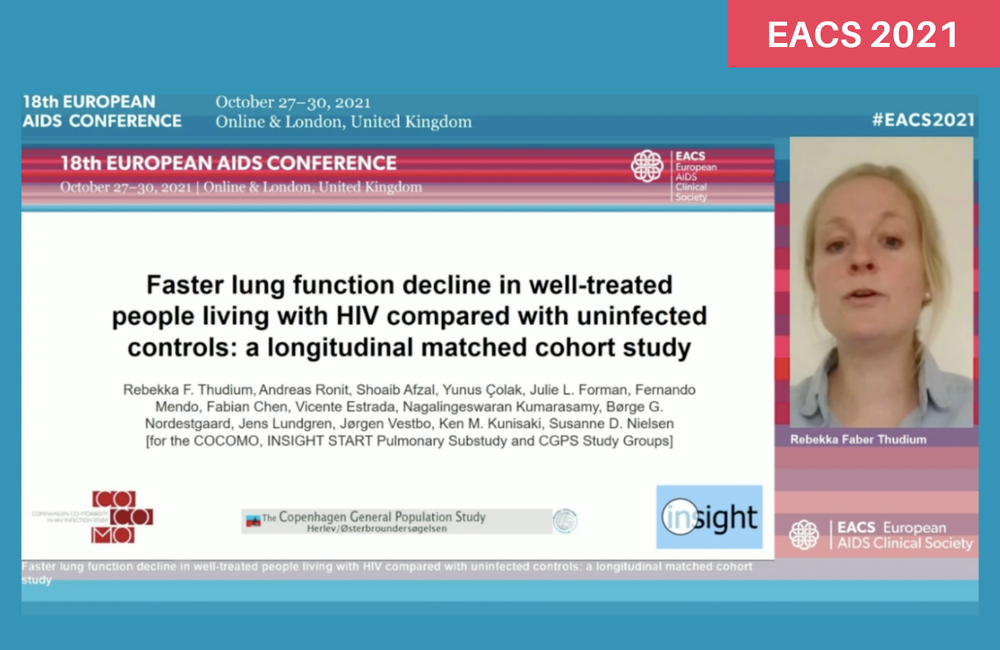
A study at the 18th European AIDS Conference (EACS 2021) showed that people living with HIV who receive effective antiretroviral therapy have a faster rate of lung function decline than HIV-negative people.
Dr Rebekka Thudium from the University of Copenhagen also told the conference that the association between HIV and lung function decline is modified by smoking, which therefore, may be more harmful in people with HIV than those without. However, lung function also declines faster in people living with HIV who never smoked, suggesting that mechanisms independent of smoking may also play a role.
Chronic lung disease is common among people with HIV. Both risk factors in the general population and HIV-related risk factors may contribute to the condition. Only a few studies have measured lung function over time in people with HIV.
Thudium and colleagues assessed how fast lung function declines in people with HIV receiving effective antiretroviral therapy, by comparison with HIV-negative people, called controls in this type of research. Their hypothesis was that well-treated people with HIV have a faster rate of lung function decline than controls.
The investigators included patients from two major observational cohort studies: 705 from the COCOMO (Copenhagen Comorbidity in HIV infection) study, and 425 from the INSIGHT START pulmonary sub-study. The comparator arm included 2895 participants from the Copenhagen General Population Study (CGPS), which is another cohort study with 100,000 HIV-seronegative people who live in the same geographical region. The two groups were matched on age in 5-year age strata and on sex.
To participate in the study, both people with HIV and controls had to be at least 25 years old and have had two valid spirometry tests (measuring airflow into and out of the lungs with a spirometer), separated by at least two years of follow-up. Having been on antiretroviral therapy for at least six months was an additional inclusion criterion for people with HIV.
Measured by spirometry, the study primary outcome was the annual rate of decline in Forced Expiratory Volume1, or FEV1 (ml/year), which is the maximal amount of air a person can forcefully exhale in one second.
The secondary outcomes were the rapid lung function decline, defined as an FEV1 decline of over 40ml/year, and the annual rate of the Forced Vital Capacity, or FVC, decline (ml/year). The FVC is the total amount of air a person can blow out in one complete breath, after breathing in deeply.
Male sex was equally distributed in people with HIV and in controls, amounting to around 80% in both groups. People with HIV were slightly younger than controls (mean age 47 versus 49 years, p-value <0.001). There were fewer participants of White ethnicity among people with HIV than among controls (70.1% versus 99.9%, p<0.001) and the majority of people with HIV had a suppressed viral load (93.7%). There were more current smokers among people with HIV than among controls (28.2% versus 18.5%, respectively).
At baseline, lung function was lower in people with HIV than in controls.
The annual rate of lung function (FEV1) decline was faster in people with HIV than in controls, with a difference of 8.5ml/year. Differences were found between people with HIV and controls, in current, former and never smokers. However, the largest difference was observed in current smokers living with HIV, showing that they have an extra 16.8ml annual rate of lung function decline when compared with HIV-negative smokers. “The association between HIV and lung function decline is amplified by the presence of active smoking,” Thudium said.
Turning to the lung function rapid decline, quite significant differences were also found in the same subgroups, between HIV-positive and HIV-negative participants. The table shows the proportion with a decline over 40ml/year.
|
|
HIV |
Controls |
p-value |
|
All |
44% |
27% |
<0.001 |
|
Current smokers |
49% |
38% |
0.001 |
|
Former smokers |
40% |
28% |
<0.001 |
|
Never smokers |
42% |
22% |
<0.001 |
Likewise, the decline in Forced Vital Capacity was greater by some 18ml/year in people with HIV (35.2 in HIV-positive people versus 17.5 in controls).
Referring to the 8.5ml/year difference in annual lung function between people with HIV and controls, Thudium said that, as life expectancy continues to increase in people living with HIV, this finding is likely to reflect negatively in lung function decline over a whole lifespan. The role of smoking in a further lung function decline in people with HIV also raises serious concerns.
Thudium RF et al. Faster lung function decline in well-treated people living with HIV compared with uninfected controls: a longitudinal matched cohort study. 18th European AIDS Conference, London, abstract OS2/2, 2021.
View the abstract on the conference website.
Update: Following the conference presentation, this study was published in a peer-reviewed journal:
Thudium RF et al. Faster lung function decline in people living with HIV despite adequate treatment: a longitudinal matched cohort study. Thorax, 78:535-542, February 2023.
